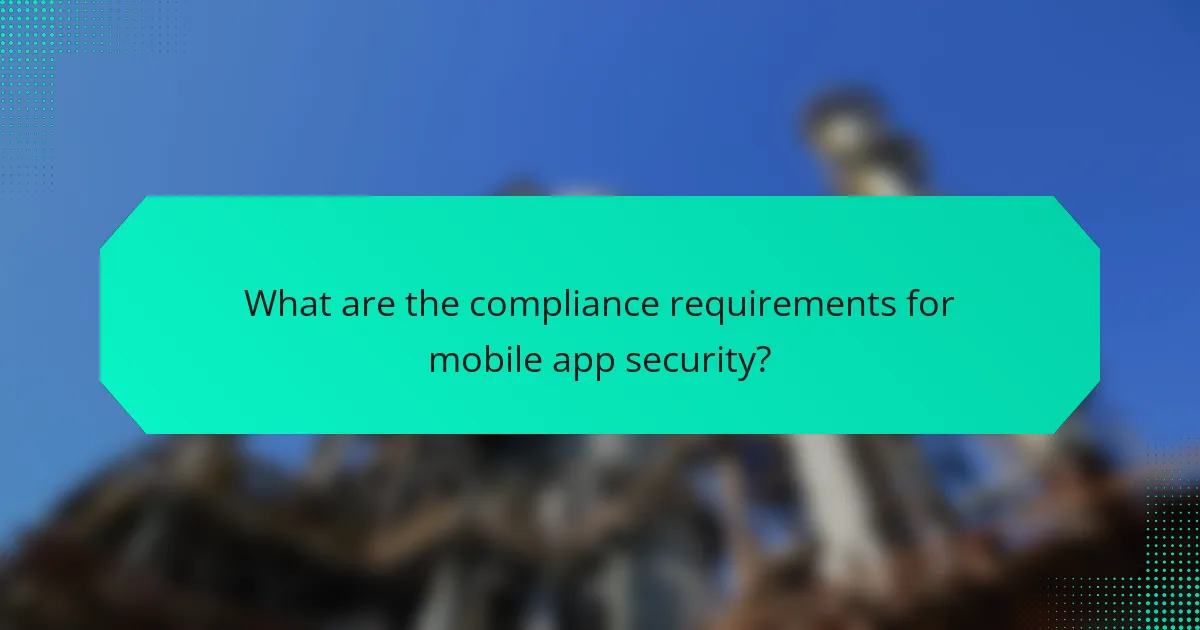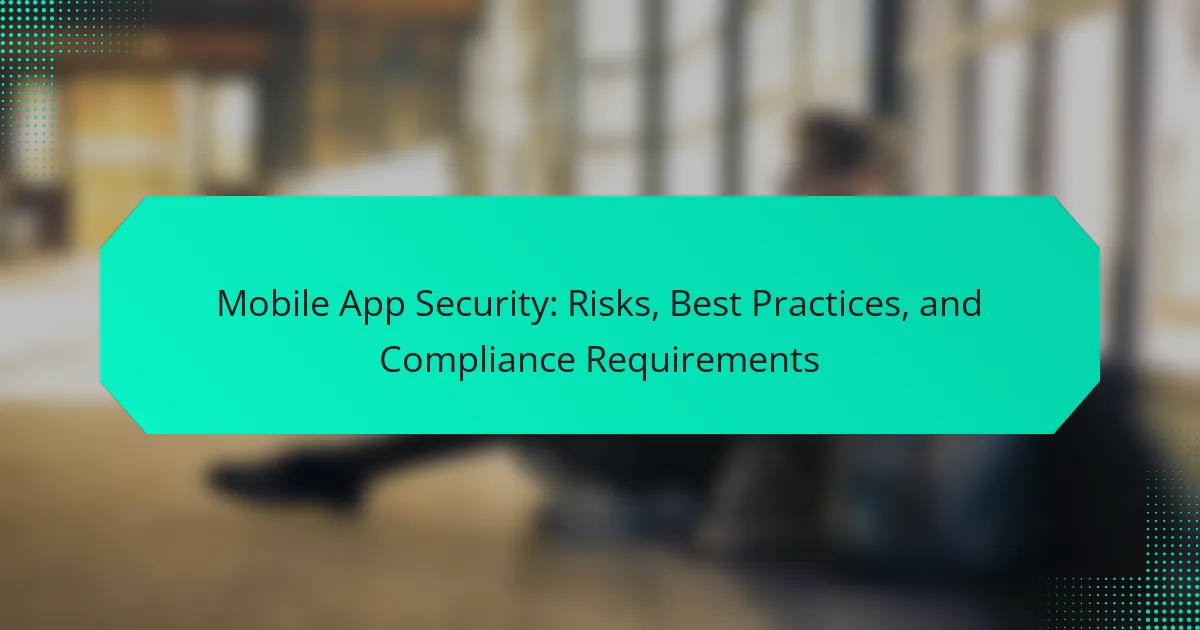Mobile app security involves the measures and practices aimed at protecting mobile applications from various threats, ensuring the safety of user data and the integrity of the app. Key techniques include encryption, authentication, secure coding practices, and regular updates to mitigate vulnerabilities. The article highlights the prevalence of security vulnerabilities in mobile apps, with a report indicating that 80% of them are at risk. It also emphasizes the importance of compliance with regulations such as GDPR, HIPAA, and PCI DSS, which mandate specific security standards. Best practices for enhancing mobile app security are outlined, including thorough security testing and user education on safe app usage.

What is Mobile App Security?
Mobile app security refers to the measures and practices designed to protect mobile applications from threats. This includes safeguarding data and ensuring the integrity of the app. Mobile app security encompasses various techniques, such as encryption, authentication, and secure coding practices. These techniques help prevent unauthorized access and data breaches. According to a 2020 report by the Mobile Security Alliance, 80% of mobile apps have security vulnerabilities. Therefore, implementing robust security measures is essential for protecting user data and maintaining trust.
Why is Mobile App Security important?
Mobile app security is important to protect sensitive user data and maintain trust. With the increasing use of mobile apps, data breaches have become more common, affecting millions of users. According to a report by IBM, the average cost of a data breach in 2021 was $4.24 million. Mobile apps often handle personal information, financial details, and authentication credentials. If compromised, this data can lead to identity theft and financial loss for users. Furthermore, mobile app security is essential for compliance with regulations like GDPR and HIPAA. Non-compliance can result in hefty fines and legal issues for businesses. Therefore, investing in mobile app security measures is crucial for safeguarding users and ensuring regulatory adherence.
What are the potential consequences of poor mobile app security?
Poor mobile app security can lead to significant consequences. These include data breaches that expose sensitive user information. Such breaches can result in identity theft and financial loss for users. Companies may face legal repercussions and regulatory fines due to non-compliance with data protection laws. Additionally, poor security can damage a brand’s reputation, leading to loss of customer trust. Malware attacks can compromise device functionality and user privacy. In severe cases, attackers may gain control over devices, leading to unauthorized access to personal accounts. Overall, the implications of inadequate mobile app security are far-reaching and detrimental.
How does mobile app security impact user trust?
Mobile app security directly impacts user trust by ensuring the protection of personal data. When users perceive an app as secure, they are more likely to engage with it. A study by IBM found that 70% of consumers consider security a key factor in their app choices. Additionally, breaches can lead to significant financial losses for users, which erodes trust. Apps with robust security measures, such as encryption and regular updates, foster a sense of safety. This trust is crucial for user retention and brand loyalty. Ultimately, enhanced security leads to increased user confidence and a positive app reputation.
What are the key components of mobile app security?
The key components of mobile app security include data encryption, secure authentication, and regular updates. Data encryption protects sensitive information by converting it into a secure format. Secure authentication ensures that only authorized users can access the app. Regular updates fix vulnerabilities and enhance security features.
Moreover, secure coding practices prevent common vulnerabilities like SQL injection and cross-site scripting. Implementing secure APIs is crucial for safe communication between the app and servers. User education on security best practices also plays a significant role in protecting app integrity. These components collectively strengthen mobile app security against threats.
What role do authentication and authorization play in mobile app security?
Authentication and authorization are critical components of mobile app security. Authentication verifies the identity of users before granting access. This process ensures that only legitimate users can access sensitive data and functionalities. Authorization determines the permissions assigned to authenticated users. It controls what resources users can access and what actions they can perform within the app.
Together, these processes protect against unauthorized access and data breaches. A study by the Ponemon Institute found that 60% of data breaches are linked to weak authentication practices. Implementing strong authentication and authorization mechanisms significantly reduces security risks. Thus, they play an essential role in safeguarding mobile applications and user data.
How do encryption and data protection contribute to mobile app security?
Encryption and data protection are essential for mobile app security. They safeguard sensitive information from unauthorized access. Encryption transforms data into a coded format, making it unreadable without the correct decryption key. This process ensures that even if data is intercepted, it remains secure. Data protection measures, such as secure storage and access controls, further enhance security by limiting who can view or manipulate data. According to a 2022 study by the Ponemon Institute, 70% of data breaches involve unencrypted data. This statistic underscores the importance of encryption in preventing data exposure. Together, these practices create a robust defense against cyber threats, ensuring user trust and compliance with regulations.
What are the common risks associated with mobile app security?
Common risks associated with mobile app security include data breaches, insecure data storage, and inadequate authentication. Data breaches can expose sensitive user information, leading to identity theft. Insecure data storage may allow unauthorized access to stored data on devices. Inadequate authentication processes can enable unauthorized users to access the app. Other risks include malware attacks, code injection, and insufficient encryption. Malware can compromise app functionality and user data. Code injection vulnerabilities can allow attackers to manipulate app behavior. Insufficient encryption may result in data being intercepted during transmission. Each of these risks highlights the importance of implementing robust security measures in mobile app development.
What types of vulnerabilities are most prevalent in mobile apps?
The most prevalent vulnerabilities in mobile apps include insecure data storage, weak server-side controls, and insufficient transport layer protection. Insecure data storage allows sensitive information to be accessed by unauthorized users. Weak server-side controls can lead to unauthorized access and data breaches. Insufficient transport layer protection fails to encrypt data in transit, exposing it to interception. According to the OWASP Mobile Security Project, these vulnerabilities are common due to the rapid development cycles of mobile applications. Additionally, a report by Veracode highlights that 70% of mobile apps contain at least one vulnerability. These statistics emphasize the critical need for robust security measures in mobile app development.
How can malware affect mobile app security?
Malware can significantly compromise mobile app security. It can steal sensitive user data, such as passwords and financial information. Malware can also manipulate app functionality, leading to unauthorized actions. Furthermore, it can create backdoors for attackers to gain persistent access. In 2021, over 1.4 billion malware attacks were reported globally, showcasing the scale of the threat. Malware can also disrupt app performance, causing crashes and loss of functionality. This not only affects user experience but can also lead to financial loss for businesses. Protecting against malware is crucial for maintaining mobile app security.

What are the best practices for ensuring mobile app security?
Implementing best practices for mobile app security is essential to protect user data and maintain trust. Start by using secure coding practices to minimize vulnerabilities. Regularly update the app to patch security flaws and enhance features. Employ encryption for data storage and transmission to safeguard sensitive information. Implement strong authentication mechanisms to verify user identities securely. Conduct thorough security testing, including [censured] testing, to identify potential weaknesses. Use secure APIs to prevent unauthorized access and data breaches. Monitor app behavior for unusual activity to detect potential threats. Lastly, educate users on security best practices to promote safe usage.
How can developers implement secure coding practices?
Developers can implement secure coding practices by following established guidelines and methodologies. They should adopt the OWASP Top Ten as a foundational reference. This list identifies the most critical security risks in web applications. Developers must validate user input to prevent injection attacks. They should also implement proper authentication and session management. Using encryption for sensitive data is essential to protect information. Regularly updating libraries and frameworks reduces vulnerabilities. Conducting code reviews and security testing helps identify potential issues early. Training in secure coding practices enhances developer awareness and skills.
What tools can assist in identifying security vulnerabilities during development?
Static Application Security Testing (SAST) tools assist in identifying security vulnerabilities during development. These tools analyze source code for vulnerabilities without executing the program. Examples include Checkmarx, Veracode, and Fortify. Dynamic Application Security Testing (DAST) tools also identify vulnerabilities by testing running applications. Examples include OWASP ZAP and Burp Suite. Interactive Application Security Testing (IAST) combines elements of SAST and DAST. Tools like Contrast Security provide real-time analysis during runtime. Security scanners like Nessus and Qualys can detect vulnerabilities in the application environment. Utilizing these tools enhances the security posture of mobile applications during development.
How does regular security testing improve mobile app security?
Regular security testing significantly enhances mobile app security by identifying vulnerabilities before they can be exploited. This proactive approach allows developers to patch security flaws early in the development cycle. Regular testing also ensures compliance with industry standards and regulations, which can mitigate legal risks. Additionally, it helps in maintaining user trust by safeguarding sensitive data against breaches. According to a 2022 report by Veracode, applications that undergo regular security testing experience 60% fewer vulnerabilities than those that do not. This statistic underscores the critical role of consistent security assessments in fortifying mobile applications.
What measures can be taken to protect user data in mobile apps?
Implementing strong encryption is essential to protect user data in mobile apps. Encryption secures data both at rest and in transit. Regularly updating the app helps patch vulnerabilities. Employing secure coding practices minimizes the risk of exploitation. User authentication methods, such as two-factor authentication, enhance security. Limiting data access based on user roles reduces exposure. Conducting regular security audits identifies potential weaknesses. Compliance with regulations like GDPR ensures user data protection. These measures collectively strengthen mobile app security and safeguard user information.
How can data encryption enhance user data protection?
Data encryption enhances user data protection by converting information into a secure format. This process ensures that only authorized users can access the original data. Encrypted data is unreadable without the correct decryption key. Thus, even if cybercriminals intercept the data, they cannot decipher it. According to a study by the Ponemon Institute, 60% of organizations that use encryption report fewer data breaches. This statistic underscores the effectiveness of encryption in safeguarding sensitive information. Additionally, encryption complies with regulatory standards such as GDPR and HIPAA, which mandate data protection measures. Therefore, implementing data encryption significantly reduces the risk of unauthorized access and data breaches.
What are the benefits of using secure APIs in mobile app development?
Secure APIs in mobile app development enhance data protection and user privacy. They ensure that sensitive information is encrypted during transmission. This encryption prevents unauthorized access and data breaches. Secure APIs also implement authentication and authorization measures. These measures verify user identities and restrict access to authorized users only.
Using secure APIs reduces the risk of common vulnerabilities, such as SQL injection and cross-site scripting. According to the OWASP Top Ten, these vulnerabilities are prevalent in insecure APIs. By adhering to secure API practices, developers can comply with regulations like GDPR and HIPAA. Compliance helps avoid legal penalties and builds user trust. Overall, secure APIs contribute to a robust mobile app security framework.
How can user education contribute to mobile app security?
User education significantly enhances mobile app security by informing users about potential threats. Educated users are more aware of phishing attempts and malicious links. They are less likely to download unverified apps, reducing exposure to malware. Training on strong password practices can prevent unauthorized access. Users educated on privacy settings can better protect their personal information. According to a study by the Ponemon Institute, organizations that invest in user training experience a 50% reduction in security incidents. This demonstrates the effectiveness of user education in mitigating risks associated with mobile app usage.
What security awareness practices should users adopt?
Users should adopt several security awareness practices to enhance mobile app security. First, they must regularly update their apps to patch vulnerabilities. Keeping software current minimizes exposure to known threats. Second, users should only download apps from trusted sources, such as official app stores. This practice reduces the risk of malware infections. Third, users must enable two-factor authentication when available. This adds an extra layer of security to accounts. Fourth, they should be cautious with public Wi-Fi connections. Using a VPN can help protect sensitive data on unsecured networks. Fifth, users need to be aware of phishing attempts. Recognizing suspicious links and emails can prevent unauthorized access. Lastly, educating themselves about security best practices is essential. Continuous learning about emerging threats keeps users informed and vigilant.
How can users recognize phishing attempts related to mobile apps?
Users can recognize phishing attempts related to mobile apps by looking for specific red flags. Unofficial app sources are a major indicator. Apps downloaded from third-party sites often pose higher risks. Suspicious links in messages or emails should be avoided. Legitimate companies typically do not ask for sensitive information via these channels. Check for spelling errors or unusual language in communications. Authentic apps usually have verified developer information. Users should also examine app permissions; excessive requests can signal phishing attempts. Regularly updating apps helps mitigate risks, as updates often include security patches.

What are the compliance requirements for mobile app security?
Compliance requirements for mobile app security include adherence to regulations such as GDPR, HIPAA, and PCI DSS. GDPR mandates data protection and privacy for users in the EU. HIPAA requires safeguarding sensitive health information in healthcare apps. PCI DSS sets security standards for apps handling payment card data. Additionally, apps must implement secure coding practices and regular security assessments. Compliance ensures user trust and protects against data breaches. Organizations must stay updated on evolving regulations to maintain compliance.
What regulations must mobile apps adhere to for security compliance?
Mobile apps must adhere to several regulations for security compliance. Key regulations include the General Data Protection Regulation (GDPR), which mandates data protection and privacy for users in the European Union. The Health Insurance Portability and Accountability Act (HIPAA) applies to apps handling healthcare data, ensuring patient information is protected. The Children’s Online Privacy Protection Act (COPPA) governs apps targeting children under 13, requiring parental consent for data collection. Additionally, the Payment Card Industry Data Security Standard (PCI DSS) is crucial for apps processing payment information. Compliance with these regulations is essential for protecting user data and avoiding legal consequences.
How do GDPR and CCPA impact mobile app security practices?
GDPR and CCPA significantly influence mobile app security practices by enforcing strict data protection standards. GDPR mandates that apps implement robust security measures to protect personal data. This includes encryption, access controls, and regular security assessments. CCPA requires similar protections, emphasizing user rights regarding data access and deletion. Both regulations necessitate transparency in data handling practices. Non-compliance can result in substantial fines, incentivizing developers to prioritize security. According to the European Data Protection Board, GDPR violations can incur penalties up to €20 million or 4% of annual global turnover. CCPA fines can reach $7,500 per violation. Thus, adherence to these laws is crucial for mobile app security.
What are the consequences of non-compliance with security regulations?
Non-compliance with security regulations can lead to significant legal and financial consequences. Organizations may face hefty fines imposed by regulatory bodies. These fines can reach millions of dollars, depending on the severity of the violation. Additionally, non-compliance can result in legal actions from affected parties. This may include lawsuits from customers or partners whose data was compromised.
Reputational damage is another consequence of non-compliance. Companies may lose customer trust, leading to decreased sales and market share. Furthermore, non-compliance can lead to increased scrutiny from regulators in the future. This can result in more frequent audits and oversight.
In some cases, organizations may be required to implement costly remediation measures. This can strain financial resources and divert attention from core business activities. Overall, the implications of non-compliance with security regulations can be severe and far-reaching.
How can organizations ensure they meet compliance requirements?
Organizations can ensure they meet compliance requirements by implementing a comprehensive compliance program. This program should include regular audits to assess compliance with applicable laws and regulations. Training employees on compliance policies is essential to ensure understanding and adherence. Organizations must also document their compliance efforts thoroughly. Utilizing compliance management software can streamline tracking and reporting. Regularly updating policies to reflect changes in regulations is crucial. Engaging with legal experts can provide guidance on complex compliance issues. Monitoring industry standards helps organizations stay aligned with best practices. These steps collectively foster a culture of compliance within the organization.
What steps should be taken to conduct a compliance audit for mobile apps?
Identify the compliance standards applicable to the mobile app. This may include GDPR, HIPAA, or PCI DSS. Gather documentation related to the app’s data handling and processing practices. Review the app’s privacy policy and terms of service for compliance with regulations. Conduct a risk assessment to identify potential compliance gaps. Evaluate the app’s security measures, including encryption and access controls. Test the app for vulnerabilities that could lead to data breaches. Document findings and create a report detailing compliance status and recommendations. Implement necessary changes based on the audit findings to ensure ongoing compliance.
How can organizations stay updated on changing compliance standards?
Organizations can stay updated on changing compliance standards by implementing regular training programs. These programs ensure that employees are informed about the latest regulations. Additionally, subscribing to industry newsletters and regulatory updates is crucial. This provides timely information on compliance changes. Engaging with compliance experts through consultations or workshops is also beneficial. This allows organizations to gain insights into complex regulations. Furthermore, utilizing compliance management software can automate updates and alerts. This technology helps track compliance requirements effectively. Regular audits and assessments can identify gaps in compliance knowledge. This proactive approach ensures organizations remain compliant with evolving standards.
What are the future trends in mobile app security compliance?
Future trends in mobile app security compliance include increased regulatory scrutiny and the adoption of advanced security frameworks. Regulatory bodies are implementing stricter guidelines to protect user data. This is driven by rising privacy concerns and data breaches. Companies are expected to adopt frameworks like the NIST Cybersecurity Framework and ISO/IEC 27001. These frameworks provide structured approaches to managing security risks. Additionally, the use of AI and machine learning in security compliance is on the rise. These technologies help identify vulnerabilities and automate compliance processes. Furthermore, organizations will prioritize user education on security best practices. This trend aims to empower users to recognize potential threats. Overall, the landscape of mobile app security compliance is evolving rapidly.
How might emerging technologies influence mobile app security regulations?
Emerging technologies can significantly influence mobile app security regulations. Technologies such as artificial intelligence and machine learning enhance threat detection capabilities. They enable real-time monitoring and response to security breaches. Blockchain technology can improve data integrity and user authentication processes. This leads to stricter regulations on data handling and privacy. Additionally, advancements in encryption techniques may prompt regulatory updates to ensure compliance with security standards. The rise of Internet of Things (IoT) devices also necessitates new regulations to address vulnerabilities in interconnected systems. Overall, as technology evolves, regulatory frameworks must adapt to mitigate new security risks effectively.
What role will artificial intelligence play in future mobile app security compliance?
Artificial intelligence will play a significant role in enhancing future mobile app security compliance. AI can automate the monitoring of compliance with security standards. This includes real-time analysis of app behavior to detect vulnerabilities. AI algorithms can identify patterns associated with security threats. They can also help in predicting potential compliance breaches before they occur. Furthermore, AI can streamline the auditing process by providing insights into security practices. According to a report by Gartner, AI-driven security solutions can reduce the time to detect threats by up to 90%. This demonstrates AI’s potential to improve compliance measures effectively.
What are the practical tips for enhancing mobile app security?
Implementing strong mobile app security involves several practical tips. First, use encryption to protect sensitive data both in transit and at rest. This ensures that even if data is intercepted, it remains unreadable. Second, apply secure coding practices to mitigate vulnerabilities. This includes input validation and error handling to prevent attacks like SQL injection. Third, regularly update the app to patch security flaws. Keeping software up to date is crucial for protecting against new threats. Fourth, implement multi-factor authentication to add an extra layer of security for user access. This method significantly reduces the risk of unauthorized access. Fifth, conduct regular security audits and [censured] testing to identify and address potential weaknesses. These proactive measures help maintain a robust security posture. Lastly, educate users about security best practices. Informed users are less likely to fall victim to phishing and other social engineering attacks.
Mobile app security encompasses the measures and practices designed to protect mobile applications from various threats, including data breaches and unauthorized access. The article highlights the importance of mobile app security in safeguarding sensitive user data and maintaining user trust, emphasizing the potential consequences of poor security practices. Key components of effective mobile app security include encryption, secure authentication, and regular updates, while compliance with regulations like GDPR and HIPAA is crucial for legal adherence. Additionally, the article outlines best practices for developers and users to enhance security, as well as the evolving landscape of compliance requirements influenced by emerging technologies.


